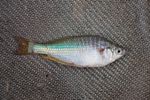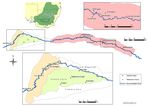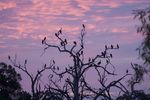THE BIDGEE BULLETIN - Environment.gov.au
←
→
Page content transcription
If your browser does not render page correctly, please read the page content below
MARCH 2021 ISSUE 7
THE BIDGEE BULLETIN
Quarterly Newsletter of the Murrumbidgee Monitoring Program
THE YEAR IN REVIEW Welcome to Issue 7 of The Bidgee Bulletin. The
monitoring season is now complete so in this
issue we look back on some highlights from the
Waterbirds
2020-21 water year. We also focus on some of
The highlight of the 2020-21 season was the spectacular
the critters we regularly saw and give some
waterbird breeding event at Eulimbah Swamp. More than
insight into how plants play important roles in
18,000 breeding pairs of straw-necked and glossy ibis
floodplain landscapes, regardless of size.
took advantage of environmental water that filled the
Finally, we chat to Gilad Bino, who is a
swamp in spring and settled into the lignum to lay eggs
conservation biologist at the University of New
and raise chicks. The water level in the swamp was
South Wales.
maintained throughout the event to maximise breeding
success. Across our sites in the lowbidgee and mid-
Murrumbidgee it was great to see significant numbers of
breeding Australian white ibis; nankeen night herons;
great and intermediate egrets; yellow-billed and royal
spoonbills; great, little black and little pied cormorants;
darters; swans; Eurasian coots; hoary-headed, great
The Bidgee Bulletin is a quarterly newsletter
crested and Australasian grebes; and white-faced
designed to provide updates on our progress as
herons. Endangered Australasian bitterns were also
we monitor the ecological outcomes of
heard booming at several sites and we’ve got our fingers
Commonwealth environmental water flows in the
crossed that they also had a successful season.
Murrumbidgee Selected Area. The 2019-2022
program builds on the previous five year
Vegetation
monitoring period (2014-2019) and uses many
Compared to previous years, inundation with
of the same methods.
environmental water was deeper and lasted longer atsome of the monitored wetlands, topped up by rainfall late in the year.
Consequently, we saw a strong response in wetland vegetation, particularly
species that tolerate deep water such as common and red watermilfoil, common
spike rush and floating pondweed. There was also growth of water primrose,
nardoo, several starworts and new lignum at several sites. Early in the year we
saw black box in poor condition at Avalon Dam but after the first almost
complete inundation of the wetland since 2016 flowering trees were observed in
January, which was a great result. Although McKennas Lagoon in the mid-
Murrumbidgee remains dry, dense stands of Australian hollyhock were
observed there for the first time. Australian hollyhock was also found at several
other wetlands across the region.
Frogs
Frogs also responded well to the wet conditions. Call diversity was consistently
high across the catchment and all six expected species were seen or heard
during the surveys, including the endangered southern bell frog, which called in
large choruses at several sites. We observed record numbers of tadpoles,
including more than 1,700 individuals of Limnodynastes species in a single fyke
net at Two Bridges Swamp. Recruitment success is yet to be determined but we
expect it to be a good year—with some luck the tadpoles escaped the beaks of
all the hungry waterbird fledglings.
Fish
Native fish catch in the wetlands was dominated by carp gudgeon, with smaller
but consistent numbers of Australian smelt, flathead gudgeon and bony bream.
We also caught several rainbow fish in the Lowbidgee lagoons and un-specked
hardyheads were recorded at Coonancoocabil in the mid-Murrumbidgee.
Notably, a 630-mm adult Murray cod was recorded at Waugorah Lagoon in
September 2020 and a juvenile golden perch in Yarradda West Lagoon in
March 2021. We had very high numbers of juvenile introduced carp and goldfish
in Piggery Lake and Two Bridges Swamp in November but captures were
greatly reduced by January, probably owing to the large numbers of birds in the
region. Of some concern is the large increase in Oriental weatherloach
numbers recorded at several sites, particularly Avalon Dam where over 300
individuals were recorded in a small fyke net. This introduced species was first
recorded in Victoria in the 1980s and has since spread into the Murrumbidgee
catchment.
Reptiles
Murray River short-necked turtles, eastern long-necked turtles and broad-
shelled turtles of all age groups were recorded in low but consistent numbers
across the region. At least one species was detected at almost every monitored
From top: sunrise in Gayini Nimmie-Caira;
site. Five more grey snakes were equipped with identification microchips at Nap
Murray-Darling rainbow fish; cormorants and
ibis at Avalon Dam; we always have two furry Nap Swamp as part of the project investigating their abundance and
volunteers helping us at Gooragool Lagoon; distribution. Incidental sightings were made at Telephone Creek and on Loorica
setting nets at Eulimbah Swamp; a juvenile Road and grey snakes were also regularly observed out and about at night at
grey snake. Two Bridges Swamp—apparently we weren’t the only ones surveying for frogs!KNOW YOUR TADPOLES
There are six species of spring-summer-calling frog that inhabit the mid-
Murrumbidgee and lowbidgee wetlands. Monitoring frog populations is an
important part of the MER program and relating information about frog presence
Southern bell frog Litoria raniformis and abundance with vegetation, water depth, water quality and weather gives us
a great insight into how these native amphibians are taking advantage of
environmental water flows. In the past, as soon as water has reached our sites
the frogs have started to breed. At first, males begin calling at night in an effort to
attract mates and soon after eggs are laid in a jelly-like mass. Tadpoles are
voracious feeders and after hatching they can be seen swimming around during
the day looking for food. Over a period of several weeks the fascinating process
of metamorphosis occurs as these larvae slowly grow legs and resorb their tails.
Peron's tree frog Litoria peronii
We often see frogs with tails out of the water and getting on with things as soon
as they can!
We’ve monitored frogs since the beginning of the project and our surveys have
two standard components: 1) we walk spotlighting transects at night and count
the number of frogs we hear calling or see hopping around and 2) we catch
tadpoles in fyke nets, sometimes in enormous numbers. In each case we identify
Giant banjo frog Limnodynastes interioris them to species and measure the length of a subset to estimate their age.
Identifying slippery tadpoles is trickier than identifying frogs but there a number of
features that can be used to help figure out who’s who. These include the size,
shape and colour of the whole tadpole, as well as the distance between the eyes
or nostrils, mouth shape and position, tail musculature and shape, and the
presence of stripes or spots. Noting down the developmental stage is also
Either a barking marsh frog Limnodynastes important because knowing whether they are simple swimmers or already
fletcheri or a spotted marsh frog hopping about will not only help with identification, but also give us a good idea
Limnodynastes tasmaniensis (the tadpoles about when the adults spawned and how many offspring are surviving.
are often too difficult to distinguish in the
field)
MURRUMBIDGEE TURTLES
We regularly detect three species of turtle at our sites: the Murray River short-
The three turtle species at our sites: the necked turtle Emydura macquarii, the eastern long-necked turtle Chelodina
Murray River short-necked turtle (top); longicollis and the broad-shelled turtle Chelodina expansa. Turtles are long-lived
eastern long-necked turtle (bottom left); and can occur in very high densities so they play import roles as consumers in
and the broad-shelled turtle (bottom right)
aquatic food webs. Items on the menu for these three species include green
algae, detritus and carrion, crustaceans, invertebrates, fish, insects and other
organic material. Australian freshwater turtles spend most of their lives in the
water, where they feed or bury themselves in the mud to wait out the winter.
However, they are highly mobile and can travel large distance across the
landscape between water bodies. They also lay clutches of about 25 eggs in
holes dug on dry land where they are safe from inundation but unfortunately
subject to destruction by foxes.BIG VERSUS SMALL
Of all the plant species that we see in the wetlands we monitor, river red gums
(Eucalyptus camaldulensis) and azolla (Azolla filiculoides) are most clearly at
opposite ends of the size scale. However, both play impactful roles in riverine and
floodplain communities.
River red gums are hard to miss—they are massive trees that tower over all other
plant species in the Murrumbidgee catchment, often reaching 30 m in height. They
like to get their feet wet, thriving in the moist clay soils of the floodplains, and can
cope with seasonal inundation for months at a time when wetlands fill. They
Above: a huge river red gum at Yarradda provide important habitat for birds, bats, arboreal mammals, lizards, snakes, frogs
lagoon and a straw-necked ibis rests on a
fish and insects, whether it’s among their gnarled branches, within hollows, under
river red gum branch at Avalon Dam. Below:
Anna Turner and Eva Moore wade through exfoliating bark or beneath the root system. They also hold cultural importance for
azolla at Nap Nap Swamp (photo Heremaia indigenous groups and a number of scarred trees that have been used for canoes
Titoko) and azolla ferns at Avalon Dam. or shields are visible in the Murray-Darling Basin.
Azolla are tiny, free-floating ferns that are less than three centimetres in diameter.
Their simple roots don’t touch soil and instead float beneath the surface of the
water, drawing in nutrients directly from the water column. When conditions are
good they can double their biomass in two days, spread out and form mats
covering expanses of still or slow-moving water. This can be problematic if they
reduce light needed by plants growing beneath the water surface and remove too
much oxygen from the water column. Outside wetlands, azolla is used as a
biofertiliser, in animal feed and can even remove heavy metals from water.
Map showing monitored wetlands within the three Murrumbidgee zones:
Redbank (cream), Gayini Nimmie-Caira (light green) and the mid-Murrumbidgee (pink)The next issue of The Bidgee Bulletin
is out in late June 2021. WHO'S WHO IN THE ZOO?
This issue we find out a little more about the modeller extraordinaire of the
MER project, Gilad Bino …
For more information or to join the
newsletter mailing list please visit:
https://www.csu.edu.au/research/ilws/ Name: Gilad Bino
research/environmental- Organisation: University of New South Wales and an adjunct at Charles
water/murrumbidgee-mer Sturt University
Position: Senior Lecturer
I studied at: BSc and MSc at The Hebrew University of Jerusalem (Israel),
PhD at UNSW
We're on social media too!
In my previous job I: Apart from travelling a bit around the world, I’ve been
Stay up to date with our adventures
an ecologist at the Centre for Ecosystem Science since completing my PhD
on Instagram and Twitter:
in 2011
@BidgeeMER Food attitude: I haven’t touched a carbohydrate in over three years and
never felt better
Beverage of choice: Yerba mate when the sun’s up and single malt scotch
under the stars
How would you describe your work to a child? A protector of animals and
plants
What’s the best thing about your work? To be with nature and having a
sense of purpose
Your work in three words? Science, conservation, nature
Is your career your parents fault? My own
It’s now 2030, where are you? In nature with loved ones
Flashback to 1999 – where were you then? In the army…
Given the chance, who would you like to be for a day? Myself with no work
commitments
What’s your favourite sign off? So long, and thanks for all the fish
The Murrumbidgee MER team would like to
acknowledge the consortium partners and local
landholders with whom we work.
We respectfully acknowledge the Wiradjuri,
Nari Nari and Muthi Muthi peoples,
traditional owners of the lands on which this
publication is focusedYou can also read



























































